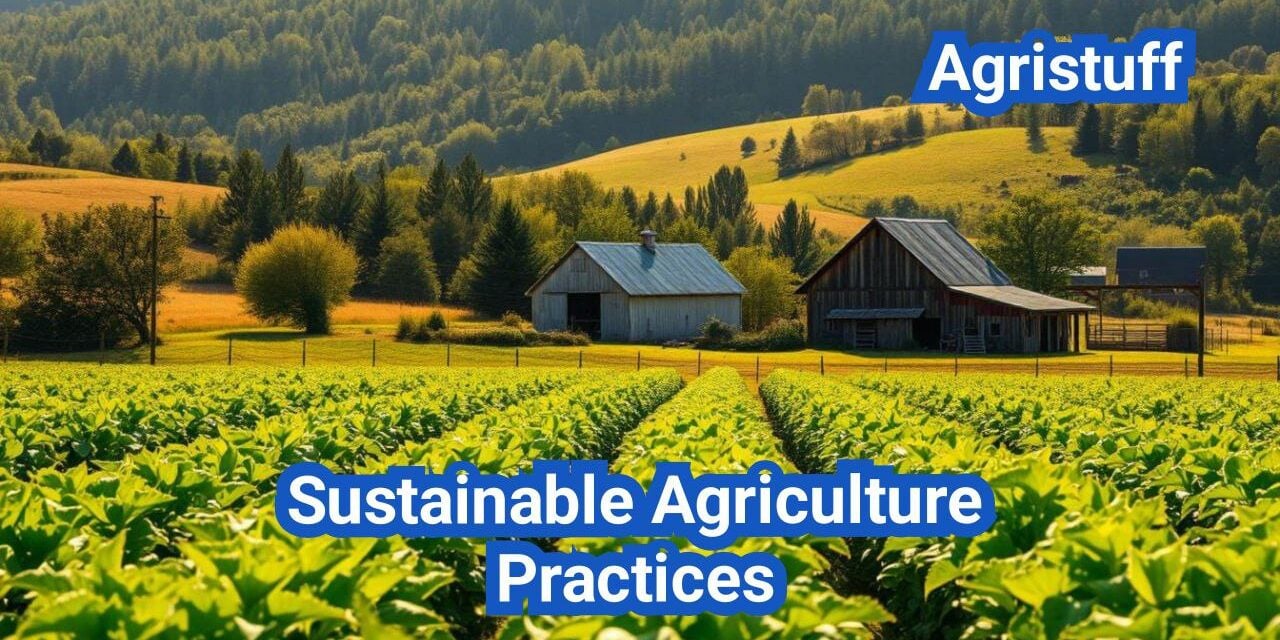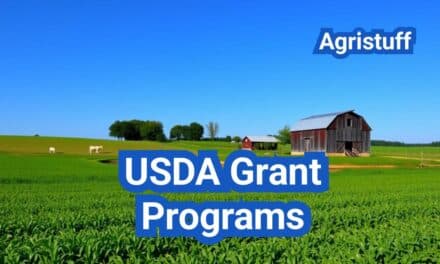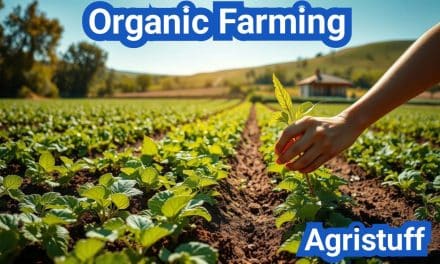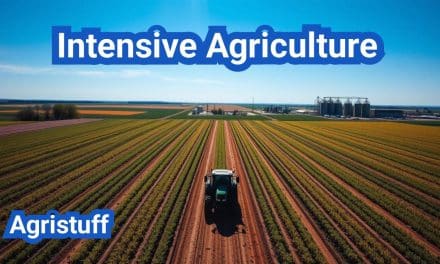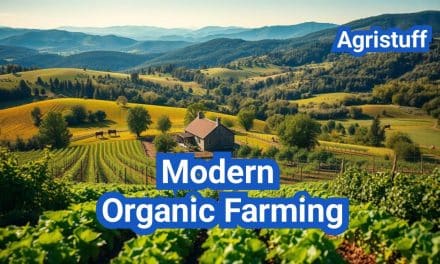Sustainable agriculture practices are crucial for the future of food security, and U.S. farms are at the forefront of adopting innovative methods to reduce costs and enhance productivity.
With the global population projected to reach 9.7 billion by 2050, the need for efficient and environmentally friendly farming techniques has never been more pressing. U.S. farms are responding by implementing a range of sustainable farming tactics that not only cut costs but also contribute to a healthier environment.
This article will explore 12 key sustainable agriculture practices being adopted by U.S. farms, highlighting their benefits and impact on the agricultural sector.
Key Takeaways
- Understanding the importance of sustainable agriculture practices in U.S. farming.
- Exploring 12 key tactics used by U.S. farms to reduce costs.
- The role of sustainable farming in enhancing environmental health.
- How sustainable agriculture practices contribute to future food security.
- The benefits of adopting sustainable agriculture methods for U.S. farms.
The Economic Case for Sustainable Agriculture Practices
Sustainable agriculture practices are gaining traction in the U.S. as a means to enhance economic resilience. The agricultural sector is a significant contributor to the U.S. economy, and the adoption of sustainable practices can have far-reaching benefits.
Current Challenges Facing U.S. Farmers
U.S. farmers are confronted with numerous challenges, including volatile market prices, increasing input costs, and environmental degradation. These challenges can significantly impact their economic viability.
- Fluctuating commodity prices affect revenue stability.
- Rising costs of inputs such as fertilizers and fuel.
- Soil erosion and water scarcity impact long-term productivity.
To mitigate these challenges, farmers are turning to sustainable agriculture practices that not only reduce environmental impact but also offer economic benefits.
How Sustainability Translates to Cost Savings
Sustainable agriculture practices can lead to significant cost savings for farmers. Some of the key practices include:
- Conservation Tillage: Reduces fuel consumption and labor costs by minimizing the number of passes over the field.
- Precision Agriculture: Optimizes input application, reducing waste and saving on fertilizers and pesticides.
- Efficient Water Use: Implements irrigation systems that reduce water consumption and lower energy costs.
By adopting these sustainable practices, farmers can not only reduce their environmental footprint but also improve their bottom line. The economic benefits of sustainable agriculture practices are clear, making a strong case for their adoption in the U.S. agricultural sector.
Understanding Sustainable Agriculture Practices in the U.S. Context

The U.S. agricultural landscape is witnessing a significant shift towards sustainable practices, driven by the imperative to ensure economic, environmental, and social sustainability. This transition is not merely a trend but a response to the growing need for practices that are economically viable, environmentally friendly, and socially responsible.
Key Principles of Agricultural Sustainability
Agricultural sustainability is founded on several key principles that guide farmers and agricultural practitioners in their pursuit of sustainable practices. Soil health practices are paramount, involving techniques such as conservation tillage, cover cropping, and organic amendments to enhance soil fertility and structure. Additionally, sustainable agriculture methods emphasize the efficient use of water resources, reduction in chemical inputs, and promotion of biodiversity.
These practices not only contribute to environmental conservation but also enhance the long-term productivity and profitability of farms. By adopting sustainable agriculture practices, farmers can reduce their dependence on external inputs, mitigate risks associated with price volatility of chemical inputs, and capitalize on market opportunities for sustainably produced products.
Balancing Economic, Environmental, and Social Factors
One of the core challenges in implementing sustainable agriculture practices is striking a balance between economic, environmental, and social factors. Economically, sustainable practices can lead to cost savings through reduced input costs and potentially higher market prices for sustainably produced goods. Environmentally, these practices contribute to soil conservation, water quality improvement, and biodiversity enhancement. Socially, they can improve the quality of life for farming communities by promoting equitable labor practices and supporting local economies.
The meaning of sustainable agriculture practices is deeply rooted in this tripartite approach, emphasizing the interdependence of economic viability, environmental stewardship, and social equity. By understanding and applying these principles, U.S. farmers can navigate the complexities of sustainable agriculture, ensuring a resilient and productive agricultural sector for the future.
Tactic 1: Conservation Tillage Systems
Farmers are increasingly turning to conservation tillage systems as a sustainable and cost-effective agricultural practice. This approach not only reduces soil erosion but also improves soil health, contributing to more resilient farming operations.
No-Till and Reduced Tillage Methods
No-till and reduced tillage methods are core components of conservation tillage systems. No-till farming eliminates the need for tillage altogether, while reduced tillage minimizes the disturbance of soil. Both methods help in preserving soil organic matter, reducing erosion, and promoting soil biota.
According to the USDA, no-till farming can reduce soil erosion by up to 90%. This significant reduction is crucial for maintaining fertile topsoil and ensuring long-term farm productivity.
“Conservation tillage is a key practice in sustainable agriculture, offering benefits that include improved soil health, reduced erosion, and increased water retention.”
— USDA Natural Resources Conservation Service
Equipment Modifications and Cost Analysis
Adopting no-till or reduced tillage methods often requires modifications to farming equipment. This can include using specialized planters and drills designed for no-till conditions. While the initial investment in such equipment can be significant, the long-term savings on fuel, labor, and equipment maintenance can be substantial.
| Equipment | Initial Cost | Annual Savings | Payback Period |
|---|---|---|---|
| No-Till Planter | $50,000 | $10,000 | 5 years |
| Reduced Tillage Drill | $30,000 | $8,000 | 3.75 years |
The cost analysis of equipment modifications for conservation tillage reveals that while there are upfront costs, the long-term benefits can lead to significant savings. Farmers should consider their specific needs and the potential return on investment when deciding on equipment modifications.
Tactic 2: Precision Agriculture Technologies

By leveraging precision agriculture technologies, farmers can significantly enhance their operational efficiency. These technologies enable farmers to make data-driven decisions, optimizing crop yields and reducing waste.
Variable Rate Application for Input Optimization
Variable rate application is a key component of precision agriculture, allowing farmers to apply inputs such as fertilizers and pesticides at varying rates across a field. This approach ensures that crops receive exactly what they need, reducing waste and environmental impact.
The use of precision agriculture tools like GPS-guided equipment and sensor technologies enables accurate application of inputs, thereby optimizing crop growth and reducing costs.
GPS and Satellite Mapping ROI
GPS and satellite mapping technologies provide farmers with detailed insights into their fields, enabling them to identify areas that require specific attention. By analyzing data from these technologies, farmers can optimize their farming practices, leading to improved crop yields and reduced costs.
The return on investment (ROI) for GPS and satellite mapping can be significant, as these technologies help farmers reduce input costs, improve crop quality, and increase overall efficiency.
Tactic 3: Water-Efficient Irrigation Systems
Implementing water-efficient irrigation systems is a crucial step towards sustainable agriculture. These systems are designed to minimize water waste while maintaining optimal crop yields.
One of the most effective methods of achieving water efficiency in irrigation is through the use of drip and micro-irrigation systems. Unlike traditional sprinkler systems, drip irrigation delivers water directly to the roots of the plants, significantly reducing evaporation and runoff.
Drip and Micro-Irrigation Implementation
Drip irrigation involves a network of tubes and emitters that release water at a controlled rate. This method is particularly beneficial for crops that are sensitive to overwatering and for fields with sandy or uneven terrain.
The implementation of drip irrigation requires careful planning, including the selection of appropriate emitter spacing and flow rates based on soil type and crop water requirements.
Soil Moisture Monitoring Technologies
To further optimize water use, farmers are increasingly turning to soil moisture monitoring technologies. These systems involve sensors placed in the soil to measure moisture levels, providing real-time data that can be used to adjust irrigation schedules.
By ensuring that crops receive water only when necessary, soil moisture monitoring can help reduce waste and improve crop health.
The combination of drip irrigation and soil moisture monitoring represents a powerful approach to water conservation in agriculture. As water resources become increasingly scarce, the adoption of these technologies is likely to play a critical role in ensuring the long-term sustainability of farming practices.
Tactic 4: Strategic Cover Cropping
Cover cropping, when done strategically, offers a multitude of benefits for agricultural operations, including improved soil structure and reduced erosion. By incorporating cover crops into their rotation, farmers can enhance soil health, reduce the need for external inputs, and potentially increase biodiversity on their farms.
Cost-Effective Cover Crop Species Selection
Selecting the right cover crop species is crucial for maximizing the benefits of cover cropping. For the Corn Belt region, species such as winter rye, clover, and radish are popular choices due to their hardiness and ability to improve soil health. The choice of cover crop should be based on factors such as climate, soil type, and the primary crop being grown.
| Cover Crop Species | Benefits | Cost Range ($/acre) |
|---|---|---|
| Winter Rye | Soil erosion control, weed suppression | 10-15 |
| Clover | Nitrogen fixation, soil improvement | 12-18 |
| Radish | Soil compaction alleviation, pest control | 15-20 |
Management Techniques to Maximize Returns
Effective management of cover crops is essential to maximize their benefits. This includes proper seeding rates, timing of planting and termination, and integration with other conservation practices. Techniques such as interseeding cover crops into standing crops can also enhance their effectiveness.
Key Management Practices:
- Optimal seeding rates and timing
- Effective termination methods
- Integration with other conservation practices
By adopting strategic cover cropping, farmers can not only improve the sustainability of their operations but also potentially increase their profitability through reduced input costs and improved soil health.
Tactic 5: Crop Rotation and Diversification

Diversifying crops and rotating them effectively is a key practice that can lead to more resilient and productive farming systems. By adopting crop rotation and diversification tactics, farmers can significantly improve soil health, reduce pest pressure, and enhance biodiversity.
Designing Profitable Rotation Sequences
Designing profitable rotation sequences requires careful planning and consideration of several factors, including soil type, climate, and market demand. A well-designed rotation sequence can help in maintaining soil fertility, reducing the need for synthetic fertilizers, and minimizing pest and disease buildup.
For instance, rotating between legumes and cereals can be particularly beneficial. Legumes fix atmospheric nitrogen, reducing the need for nitrogen-based fertilizers for subsequent crops. This not only cuts costs but also contributes to a more sustainable farming system.
“Crop rotation is a fundamental practice that can lead to significant improvements in soil health and overall farm productivity.”
— USDA
| Crop Rotation Sequence | Benefits | Potential Challenges |
|---|---|---|
| Corn-Soybean-Wheat | Improved soil fertility, reduced pest pressure | Market fluctuations for soybeans |
| Legume-Cereal Rotation | Nitrogen fixation, reduced fertilizer costs | Initial investment in legume seeds |
Market Opportunities for Diverse Crops
Diversifying crops not only improves soil health and reduces pests and diseases but also opens up new market opportunities. By growing a variety of crops, farmers can tap into different markets, potentially increasing their revenue streams.
For example, growing specialty crops like quinoa or safflower can provide access to niche markets that command higher prices. Similarly, incorporating cover crops into rotation sequences can provide additional income through sales of cover crop seeds or through ecosystem services like pollinator habitat creation.
Understanding market demand and trends is crucial for capitalizing on these opportunities. Farmers should research and stay informed about the market opportunities for diverse crops to maximize their returns.
Tactic 6: Integrated Pest Management (IPM)

The use of Integrated Pest Management tactics has become crucial in modern agriculture for sustainable pest control. IPM involves a comprehensive approach to managing pests, combining physical, cultural, biological, and chemical controls to minimize harm to people, the environment, and beneficial organisms.
Economic Thresholds for Intervention
Economic thresholds are critical in IPM as they determine when pest control measures are necessary to prevent economic loss. By understanding these thresholds, farmers can avoid unnecessary pesticide applications, reducing costs and environmental impact.
Key considerations for economic thresholds include:
- Pest population density
- Crop growth stage
- Potential yield loss
- Cost of control measures
Biological Control Cost Comparisons | Sustainable Agriculture Practices
Biological control methods, such as introducing beneficial insects or using microbial pesticides, offer a cost-effective and environmentally friendly alternative to chemical pesticides. A comparison of different biological control methods is essential to determine their efficacy and cost-effectiveness.
| Biological Control Method | Cost per Acre | Efficacy Rate |
|---|---|---|
| Beneficial Insects | $20-$50 | 70-90% |
| Microbial Pesticides | $15-$30 | 60-85% |
| Nematodes | $25-$40 | 80-95% |
By adopting IPM strategies, farmers can not only reduce their reliance on chemical pesticides but also improve crop yields and contribute to a more sustainable agricultural practice.
Tactic 7: Rotational Grazing Systems

Rotational grazing systems offer a transformative approach to livestock management, enhancing pasture productivity and reducing environmental impact. This method involves moving livestock to different areas of pasture to allow the grazed areas to recover, promoting healthier pastures and more efficient use of land.
“Rotational grazing is not just a technique; it’s a holistic approach to managing our land, livestock, and future,” says a leading agricultural expert. By adopting rotational grazing, farmers can significantly improve the sustainability of their operations.
Infrastructure Setup for Maximum ROI | Sustainable Agriculture Practices
To implement rotational grazing effectively, farmers need to set up the right infrastructure. This includes dividing pastures into smaller paddocks using fencing, and providing water and shade where necessary. The initial investment in infrastructure can be significant, but it pays off through increased productivity and reduced soil erosion.
A well-designed rotational grazing system can lead to increased pasture productivity and improved livestock health. For example, by rotating livestock through different paddocks, farmers can prevent overgrazing, allowing pastures to recover and rebuild.
Stocking Rate Optimization | Sustainable Agriculture Practices
Optimizing stocking rates is crucial for the success of rotational grazing systems. This involves determining the optimal number of livestock per acre, taking into account factors like pasture quality, climate, and livestock type. Proper stocking rates ensure that pastures are not overgrazed, maintaining their productivity over time.
Farmers can achieve stocking rate optimization by monitoring pasture conditions and adjusting livestock numbers accordingly. This might involve temporarily moving livestock to different pastures during periods of drought or high rainfall.
By combining effective infrastructure setup with optimized stocking rates, farmers can maximize the benefits of rotational grazing systems, improving both their bottom line and environmental sustainability.
Tactic 8: Manure Management Technologies

Effective manure management is crucial for sustainable agriculture practices. Manure is a valuable resource that can enhance soil fertility, improve crop yields, and reduce the need for synthetic fertilizers. However, improper management can lead to environmental issues such as water pollution and greenhouse gas emissions.
Storage and Application Systems | Sustainable Agriculture Practices
Proper storage and application systems are essential for maximizing the benefits of manure while minimizing its environmental footprint. Covered storage facilities can reduce odors and prevent runoff. Technologies such as anaerobic digesters can capture methane for energy production, reducing greenhouse gas emissions.
Nutrient Value Calculations | Sustainable Agriculture Practices
Understanding the nutrient value of manure is critical for its effective application. Manure contains essential nutrients like nitrogen, phosphorus, and potassium. By analyzing its nutrient content, farmers can apply the correct amount to meet crop needs, reducing waste and environmental impact.
“Manure is a valuable resource that can replace a significant portion of synthetic fertilizers, improving soil health and reducing environmental pollution.”
Tactic 9: On-Farm Renewable Energy Systems
On-farm renewable energy systems offer a dual benefit of reducing energy costs and enhancing energy security for farmers. By integrating renewable energy sources into their operations, farmers can significantly decrease their reliance on external energy supplies, thereby mitigating the risks associated with price volatility.
The implementation of renewable energy systems on farms is a multifaceted approach that involves assessing the farm’s energy needs and identifying the most suitable renewable energy sources. Solar and wind energy are among the most common forms of renewable energy adopted by farms due to their feasibility and the significant returns on investment they offer.
Solar and Wind Implementation Strategies | Sustainable Agriculture Practices
When it comes to implementing solar energy, farmers can choose between photovoltaic (PV) systems and solar thermal systems. PV systems convert sunlight directly into electricity, while solar thermal systems use sunlight to heat water or air for various farm applications. The choice between these systems depends on the farm’s specific energy requirements and the available solar resources.
Wind energy, on the other hand, is harnessed using wind turbines that convert the kinetic energy of the wind into electricity. The feasibility of wind energy depends on the wind speeds at the farm location, with areas having average wind speeds of at least 7-8 meters per second being considered suitable for wind energy generation.
Energy Audit and Efficiency Measures | Sustainable Agriculture Practices
Before implementing renewable energy systems, conducting an energy audit is crucial. An energy audit helps in understanding the farm’s current energy usage patterns, identifying areas of inefficiency, and determining the potential for energy savings. This process involves analyzing energy consumption data, inspecting energy-using equipment, and identifying opportunities for improving energy efficiency.
Energy efficiency measures can include upgrading to energy-efficient equipment, optimizing irrigation systems, and improving insulation in farm buildings. By reducing energy demand through efficiency measures, farmers can minimize the size and cost of the renewable energy systems required to meet their energy needs.
In conclusion, on-farm renewable energy systems are a vital component of sustainable agriculture practices, offering both economic and environmental benefits. By carefully planning and implementing these systems, farmers can achieve significant cost savings and enhance their energy security.
Tactic 10: Post-Harvest Loss Reduction Strategies

Reducing post-harvest losses is crucial for farmers to maximize their profits and minimize waste. Post-harvest losses can occur due to various factors, including improper handling, storage, and processing techniques. By implementing effective post-harvest loss reduction strategies, farmers can not only cut costs but also improve the quality of their produce, thereby enhancing their competitiveness in the market.
Storage Improvements for Extended Marketing | Sustainable Agriculture Practices
One of the key areas where post-harvest losses can be minimized is in storage. Improving storage facilities and techniques can help extend the marketing period for crops, allowing farmers to sell their produce at more favorable prices. This can involve investing in climate-controlled storage facilities, using appropriate storage containers, and implementing effective inventory management systems.
Climate-controlled storage is particularly beneficial for perishable crops, as it helps maintain optimal temperature and humidity levels, thereby reducing spoilage. For example, storing grains in hermetically sealed containers or silos can protect them from moisture and pests, preserving their quality over longer periods.
Value-Added Processing Opportunities | Sustainable Agriculture Practices
Another strategy for reducing post-harvest losses is through value-added processing. By processing their crops into higher-value products, farmers can increase their revenue per unit of produce. This not only helps in reducing the economic impact of post-harvest losses but also opens up new market opportunities.
Value-added processing can range from simple activities like cleaning and grading to more complex processes such as milling, canning, or producing jams and preserves. For instance, farmers growing fruits can process them into jams, juices, or dried fruits, thereby extending the shelf life and increasing the value of their produce.
To successfully implement post-harvest loss reduction strategies, farmers need to assess their current practices, identify areas of loss, and adopt appropriate technologies and techniques. This might involve investing in new equipment, training staff, or seeking advice from agricultural experts.
Tactic 11: Agroforestry and Habitat Integration

Agroforestry and habitat integration represent a holistic approach to farming, combining trees, crops, and livestock to enhance ecosystem services. This practice not only improves biodiversity but also contributes to more resilient farming systems.
The integration of trees into agricultural landscapes can have numerous benefits, including improved soil health, increased wildlife habitat, and enhanced ecosystem services. By adopting agroforestry practices, farmers can diversify their operations, potentially leading to increased economic returns.
Silvopasture and Alley Cropping Economics | Sustainable Agriculture Practices
Silvopasture systems, which combine trees, forage, and livestock, can provide multiple revenue streams for farmers. The trees offer timber or nuts, while the livestock produce meat or dairy products. Alley cropping, another form of agroforestry, involves growing crops between rows of trees, enhancing land use efficiency.
The economic benefits of these systems can be substantial. For example, a study on silvopasture systems found that they can increase farm profitability by up to 25% compared to traditional grazing systems.
| Practice | Economic Benefits | Ecological Benefits |
|---|---|---|
| Silvopasture | Increased livestock productivity, timber production | Improved soil health, biodiversity |
| Alley Cropping | Diversified income streams, improved crop yields | Enhanced ecosystem services, reduced erosion |
Prairie Strips and Field Border Benefits | Sustainable Agriculture Practices
Prairie strips and field borders are another aspect of habitat integration. By planting native vegetation along field edges or in strips within fields, farmers can create habitat for wildlife, reduce erosion, and improve water quality.
“The integration of prairie strips into agricultural landscapes has been shown to significantly enhance biodiversity and ecosystem services, contributing to more resilient farming systems.”
Source: Conservation Research Report
The benefits of prairie strips include improved pollinator services, reduced soil loss, and increased ecological connectivity. These practices can also contribute to a more diverse and resilient agricultural landscape.
Tactic 12: Leveraging Government Programs and Incentives
Sustainable agriculture practices can be financially bolstered by various government programs and incentives available to U.S. farmers. These initiatives are designed to encourage the adoption of environmentally friendly farming methods while providing economic benefits to the farmers.
USDA REAP Grants Application Guide | Sustainable Agriculture Practices
The United States Department of Agriculture (USDA) offers the Rural Energy for America Program (REAP) grants to support farmers in implementing renewable energy systems and improving energy efficiency. To apply for REAP grants, farmers should follow these steps:
- Determine eligibility based on USDA criteria
- Prepare a detailed project proposal
- Conduct an energy audit to justify the project
- Submit the application through the USDA’s online portal
It’s crucial to ensure that the application is thorough and includes all necessary documentation to increase the chances of approval.
NRCS EQIP vs CSP: Strategic Selection | Sustainable Agriculture Practices
The Natural Resources Conservation Service (NRCS) offers two significant programs: the Environmental Quality Incentives Program (EQIP) and the Conservation Stewardship Program (CSP). Understanding the differences between these programs is vital for strategic selection.
| Program | Primary Focus | Benefits |
|---|---|---|
| EQIP | Implementing conservation practices | Financial assistance for conservation practices, technical support |
| CSP | Maintaining and improving existing conservation efforts | Payments for maintaining and improving conservation practices, incentives for additional conservation efforts |
Farmers should assess their current conservation practices and future goals to determine which program aligns better with their needs. EQIP is ideal for those looking to implement new conservation practices, while CSP is suited for those who have existing conservation efforts and wish to maintain and improve them.
By leveraging these government programs and incentives, farmers can not only adopt sustainable agriculture practices but also enhance their economic viability.
Creating Your Farm’s Sustainable Transition Plan
A successful sustainable agriculture transition begins with a comprehensive plan that addresses the unique aspects of your farm. This plan will serve as a roadmap, guiding you through the process of adopting sustainable practices that reduce costs and improve environmental stewardship.
Farm Assessment and Baseline Establishment | Sustainable Agriculture Practices
The first step in creating a sustainable transition plan is to conduct a thorough farm assessment. This involves evaluating your farm’s current practices, resources, and challenges. By establishing a baseline, you can identify areas for improvement and opportunities for cost savings.
Key components of a farm assessment include:
- Soil health analysis
- Water usage evaluation
- Pest and disease management review
- Energy consumption assessment
Prioritizing Practices for Maximum ROI
Once you have a clear understanding of your farm’s current state, it’s essential to prioritize practices that will yield the maximum return on investment (ROI). This involves analyzing the potential benefits and costs of different sustainable practices and selecting those that best align with your farm’s goals and resources.
Consider the following when prioritizing practices:
- Potential cost savings
- Environmental impact
- Feasibility of implementation
- Long-term benefits
Timeline Development and Resource Allocation | Sustainable Agriculture Practices
With your priorities established, the next step is to develop a timeline for implementing the selected sustainable practices. This timeline should be realistic and take into account factors such as weather conditions, equipment availability, and labor resources.
Effective resource allocation is critical to the success of your sustainable transition plan. This includes allocating financial resources, equipment, and labor to support the implementation of new practices.
By following these steps and creating a well-structured sustainable transition plan, farmers can navigate the transition to sustainable agriculture practices with confidence, achieving significant cost savings and environmental benefits.
Measuring Success: Economic Metrics for Sustainable Practices
Economic metrics play a pivotal role in determining the success of sustainable farming methods. By examining these metrics, farmers and stakeholders can assess the financial viability and environmental impact of their practices.
Short-Term vs Long-Term Financial Indicators | Sustainable Agriculture Practices
When evaluating the economic success of sustainable practices, it’s crucial to differentiate between short-term and long-term financial indicators. Short-term indicators might include immediate cost savings from reduced chemical use or initial increases in crop yield due to improved soil health. Long-term indicators, on the other hand, could involve sustained improvements in soil fertility, increased biodiversity, and enhanced ecosystem services.
According to a study published in the Journal of Agricultural Economics, farms adopting sustainable practices saw a significant reduction in production costs over a five-year period compared to conventional farms.
“Our analysis indicates that sustainable farming practices not only reduce environmental degradation but also lead to improved economic performance over time.”
| Indicator | Short-Term Impact | Long-Term Impact |
|---|---|---|
| Cost Savings | Immediate reduction in input costs | Sustained cost efficiency through improved soil health |
| Crop Yield | Potential initial yield decrease | Increased yield stability and quality |
| Ecosystem Services | Limited immediate benefits | Enhanced biodiversity and ecosystem resilience |
Holistic Farm Profitability Assessment | Sustainable Agriculture Practices
A holistic assessment of farm profitability goes beyond direct financial gains, incorporating the value of ecosystem services, social benefits, and potential future opportunities. This approach recognizes that sustainable practices contribute to the overall resilience and adaptability of the farming system.
By adopting a holistic view, farmers can better understand the comprehensive benefits of sustainable practices, including improved environmental health and social equity. As noted by the USDA, “Sustainable agriculture practices are critical for maintaining the long-term productivity and health of our nation’s agricultural resources.”
The integration of economic metrics with environmental and social considerations provides a comprehensive framework for evaluating the success of sustainable agriculture practices. This approach not only aids in financial planning but also in assessing the broader impacts on the farm ecosystem and community.
Overcoming Implementation Challenges
The transition to sustainable agriculture requires more than just a change in practices; it demands a comprehensive approach to overcoming implementation challenges. Farmers must navigate a complex landscape of new techniques, financial constraints, and social dynamics.
Knowledge and Training Resources | Sustainable Agriculture Practices
One of the primary barriers to adopting sustainable agriculture practices is the lack of knowledge and training. Farmers need access to reliable resources to learn about new methods and technologies. Extension services provided by universities and government agencies play a crucial role in offering workshops, training programs, and technical assistance.
Additionally, online platforms and digital tools have become invaluable resources. Websites like the National Sustainable Agriculture Coalition provide a wealth of information on sustainable practices, including case studies and best management practices.
| Resource | Description | Benefit |
|---|---|---|
| Extension Services | Workshops, training programs, technical assistance | Hands-on learning and expert guidance |
| Online Platforms | Websites, webinars, online courses | Accessible, self-paced learning |
| Farmer Networks | Peer-to-peer learning, field days | Practical insights and community support |
Financing Options for Transition Periods | Sustainable Agriculture Practices
Transitioning to sustainable agriculture practices often requires significant upfront investments. Farmers can explore various financing options to support this transition. Government grants and low-interest loans are available through programs like the USDA’s Natural Resources Conservation Service (NRCS) Environmental Quality Incentives Program (EQIP).
Additionally, private financing options, such as impact investing and sustainable agriculture funds, are becoming increasingly popular. These financial instruments not only provide capital but also support the development of sustainable agriculture projects.
Building Support Networks and Partnerships | Sustainable Agriculture Practices
Building a network of support is crucial for farmers transitioning to sustainable practices. This includes forming partnerships with other farmers, agricultural businesses, and community organizations. Cooperatives and farmer networks can provide valuable resources, including shared equipment, marketing support, and technical expertise.
By leveraging these resources and strategies, farmers can overcome the challenges associated with implementing sustainable agriculture practices and achieve long-term success.
The Future of Cost-Effective Farming Through Sustainability
The future of farming in the United States is being reshaped by sustainable agriculture practices that not only reduce environmental impact but also cut costs for farmers. As discussed, 12 key tactics are being employed by U.S. farms to achieve cost-effective farming.
By adopting practices such as conservation tillage, precision agriculture, and strategic cover cropping, farmers can significantly reduce their operational expenses. The integration of renewable energy systems, manure management technologies, and rotational grazing systems further contributes to the economic viability of sustainable farming.
The USDA and other agricultural organizations are supporting this transition through various programs and incentives, such as the Renewable Energy and Energy Efficiency Program (REAP) and the Environmental Quality Incentives Program (EQIP).
As the agricultural sector continues to evolve, embracing sustainable practices will be crucial for long-term success. By investing in these methods, farmers can improve their bottom line while contributing to a more sustainable food system.
FAQ
What are sustainable agriculture practices?
Sustainable agriculture practices refer to farming methods that prioritize environmental stewardship, social responsibility, and economic viability. These practices aim to maintain soil health, conserve water, reduce chemical use, and promote biodiversity.
What are the benefits of conservation tillage systems?
Conservation tillage systems, including no-till and reduced tillage methods, help reduce soil erosion, improve soil health, and decrease fuel consumption. These systems can also lead to cost savings by reducing equipment wear and tear.
How does precision agriculture technology contribute to sustainable farming?
Precision agriculture technologies, such as variable rate application and GPS-guided farming, optimize input use, reduce waste, and improve crop yields. These technologies can help farmers make data-driven decisions, leading to increased efficiency and profitability.
What are the advantages of water-efficient irrigation systems?
Water-efficient irrigation systems, including drip and micro-irrigation, help conserve water, reduce energy consumption, and minimize soil salinization. These systems can also improve crop yields and quality by providing plants with the right amount of water at the right time.
How can cover cropping benefit farmers?
Cover cropping can improve soil health, reduce erosion, and increase biodiversity. By selecting the right cover crop species and implementing effective management techniques, farmers can maximize returns and minimize costs.
What is integrated pest management (IPM), and how does it work?
Integrated pest management (IPM) is a holistic approach to managing pests that combines physical, cultural, biological, and chemical controls. IPM involves setting economic thresholds for intervention, monitoring pest populations, and using a combination of control methods to minimize harm to people, the environment, and beneficial organisms.
What are the benefits of rotational grazing systems?
Rotational grazing systems can improve pasture productivity, reduce soil erosion, and promote biodiversity. By optimizing stocking rates and implementing infrastructure such as fencing and watering systems, farmers can maximize returns on investment.
How can manure management technologies benefit farmers?
Manure management technologies, including storage and application systems, can help farmers optimize nutrient use, reduce waste, and minimize environmental impacts. By calculating the nutrient value of manure, farmers can make informed decisions about fertilizer applications.
What are the advantages of on-farm renewable energy systems?
On-farm renewable energy systems, such as solar and wind power, can help farmers reduce energy costs, improve energy independence, and minimize their carbon footprint. By conducting energy audits and implementing efficiency measures, farmers can optimize their energy use.
How can farmers leverage government programs and incentives for sustainable agriculture?
Farmers can access various government programs and incentives, such as USDA REAP grants and NRCS EQIP and CSP programs, to support their transition to sustainable agriculture practices. By understanding the eligibility criteria and application processes, farmers can tap into these resources to offset costs and improve their bottom line.
What are the key steps in creating a sustainable transition plan for a farm?
Creating a sustainable transition plan involves assessing the farm’s current situation, prioritizing practices for maximum ROI, and developing a timeline for implementation. By allocating resources effectively and monitoring progress, farmers can ensure a successful transition to sustainable agriculture practices.
How can farmers measure the success of their sustainable agriculture practices?
Farmers can measure the success of their sustainable agriculture practices by tracking economic metrics such as short-term and long-term financial indicators, as well as holistic farm profitability assessments. By monitoring these metrics, farmers can evaluate the effectiveness of their practices and make adjustments as needed.
Conclusion of: Sustainable Agriculture Practices
Why sustainable agriculture practices lower expenses (and risk)
The fastest-growing U.S. farms treat sustainable agriculture practices as a cost-control system, not just a conservation effort. By narrowing inputs to what the crop or herd truly needs, these practices trim diesel, fertilizer, water, and pesticide bills—while improving soil function and resilience so yields don’t collapse when weather swings. This practical, U.S.-focused playbook outlines 12 proven tactics to cut costs this season and next, grounded in peer-reviewed economics and USDA guidance. USDA ERS: Economics of soil-health & conservation practices
1) Apply the 4R plan: Nutrient Management (NRCS 590)
A 4R plan (“right source, right rate, right time, right place”) is foundational among sustainable agriculture practices because it prevents over-application—often the most expensive mistake on a farm. Producers commonly save money where nutrients were historically overapplied by using better soil testing, split applications, and placement technologies; documented 4R plans can also unlock state and federal cost-share. NRCS: Nutrient Management (590) overview
2) Plant cover crops to replace purchased fertility
Legume covers fix nitrogen while fibrous covers scavenge leftover nutrients and suppress weeds, making sustainable agriculture practices like cover cropping a double win: fewer purchased inputs and more resilient soils. Multi-year farmer surveys show input reductions and yield stability after cover crops, with benefits compounding when paired with no-till and precision placement. SARE: Cover crops—benefits & management
3) Switch to conservation tillage/no-till to save fuel and labor
Fuel is cash. Moving from continuous conventional tillage to continuous no-till can eliminate several passes, saving fuel, labor, and equipment wear. As part of sustainable agriculture practices, no-till also preserves soil structure and moisture, which can stabilize yields in dry years and reduce erosion risk. Farmers.gov: Fuel savings with no-till
4) Use Integrated Pest Management (IPM) to cut spray costs
IPM relies on prevention (rotation, resistant varieties, planting windows), scouting, and thresholds to minimize chemical use. Positioned within sustainable agriculture practices, IPM lowers long-run costs by targeting only necessary interventions and slowing resistance. The outcome: fewer calendar sprays and steadier efficacy. EPA: IPM principles & economics
5) Upgrade irrigation: scheduling + microirrigation where it pencils
Water-use efficiency is a direct savings lever in sustainable agriculture practices. Scheduling to crop need and adopting microirrigation where suited reduces pumping energy and evaporative losses, improving water productivity per dollar spent. Pair soil-moisture measurements with variable run times to lock in gains. NRCS: Microirrigation (441) practice standard
6) Rotate pastures (managed/rotational grazing) to lower feed costs
Managed rotation moves herds through paddocks to match forage recovery, boosting utilization and reducing purchased hay. As part of sustainable agriculture practices, rotational grazing improves soil cover, spreads nutrients via manure, and enhances drought resilience—often with net savings after modest fencing/water investments. USDA Climate Hubs: Rotational grazing & resilience
7) Recycle nutrients and generate energy with anaerobic digestion
For livestock operations, digesters convert manure into biogas for heat, electricity, or vehicle fuel, plus a nutrient-rich digestate. Folded into sustainable agriculture practices, digestion can trim energy bills, reduce odor and methane emissions, and improve manure handling, sometimes opening new revenue streams. EPA AgSTAR: Benefits of anaerobic digestion
8) Take the REAP route: energy audits, efficiency, and renewables
Electricity for fans, drying, pumps, and cold storage adds up. Under sustainable agriculture practices, an energy audit helps target efficient motors, VFDs, insulation, or on-farm renewables. USDA’s Rural Energy for America Program (REAP) assists with audits and financing, shortening payback on upgrades that knock down utility bills. USDA RD: REAP energy audits & assistance
9) Go data-driven: guidance, yield mapping & variable-rate tech (VRT)
Precision tools reduce overlap and match inputs to within-field variability. Within sustainable agriculture practices, guidance, yield mapping, and VRT consistently cut fertilizer and chemical spend while improving placement efficiency and net returns, particularly in corn–soy systems. USDA ERS Amber Waves: Precision ag cost savings
10) Diversify crop rotations to break pest cycles (and bills)
Rotations improve nutrient cycling, interrupt pest/disease life cycles, and spread labor and market risk. As one of the cornerstone sustainable agriculture practices, diversified rotations reduce dependence on synthetic inputs and stabilize net margins across variable seasons. USDA ERS: Soil tillage & crop rotation
11) Add beneficial-insect habitat: field borders & prairie strips
Strategic habitat—such as prairie strips and field borders—reduces erosion and keeps nutrients on the field, while supporting predators and pollinators that enhance IPM. When embedded in sustainable agriculture practices, these strips lower runoff with minimal acreage and can modestly reduce pest pressure. Iowa State STRIPS: Research overview
12) Reduce post-harvest losses with better storage & handling
Tightening the post-harvest chain—produce cooling, grain aeration, bin monitoring—may be the most overlooked of all sustainable agriculture practices. Reducing shrink, quality loss, and spoilage converts sunk costs into salable product and boosts margin without adding acres. USDA: National Strategy on Food Loss & Waste
Bonus savings: tie practices together for compounding benefits
The biggest returns come from stacking sustainable agriculture practices—for example, cover crops + no-till + nutrient management + precision placement. Healthier soils make every input work harder, while programs like the Conservation Stewardship Program (CSP) pay annually for ongoing conservation and new enhancements to ease cash flow. NRCS: CSP overview & payments
How to prioritize on your farm (quick start)
Start with a soil-test-driven 4R plan, then layer in one or two high-ROI sustainable agriculture practices—no-till and cover crops are common first steps. Add guidance/VRT as budgets allow, and use REAP/NRCS assistance to reduce up-front cost. Livestock farms should prioritize rotational grazing and manure management, with digestion penciled where scale and incentives exist. NRCS: Payment schedules & assistance
Final thought
When you frame sustainable agriculture practices as a profitability system—less waste, fewer passes, smarter timing—the economics often work even before incentives. Start where your variable costs are highest, stack practices that reinforce each other, and track per-acre margins so the savings show up on paper, not just in the soil. USDA ERS: Precision ag adoption & productivity
Sources & References
- NRCS: Nutrient Management (590)
- SARE: Cover crops—benefits & selection
- Farmers.gov: Save money on fuel with no-till
- EPA: IPM principles
- NRCS: Microirrigation (441)
- USDA Climate Hubs: Rotational grazing
- EPA AgSTAR: Benefits of anaerobic digestion
- USDA Rural Development: REAP—energy audits & assistance
- USDA ERS Amber Waves: Precision ag cost savings
- USDA ERS: Soil tillage & crop rotation
- Iowa State STRIPS: Research overview
- USDA: National Strategy for Reducing Food Loss & Waste
- NRCS: Conservation Stewardship Program (CSP)
- NRCS: Payment schedules & assistance
- USDA ERS: Precision ag adoption & productivity
- USDA ERS: Economics of soil-health & conservation practices (ERR-353)

